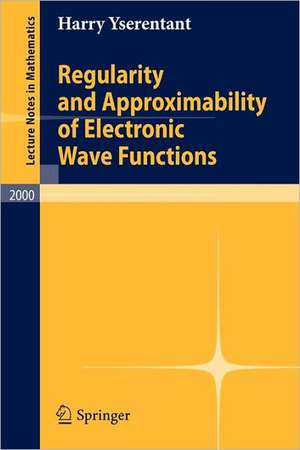Regularity and Approximability of Electronic Wave Functions: Lecture Notes in Mathematics, cartea 2000
Autor Harry Yserentanten Limba Engleză Paperback – 4 iun 2010
Din seria Lecture Notes in Mathematics
- 17%
 Preț: 360.43 lei
Preț: 360.43 lei -
 Preț: 459.92 lei
Preț: 459.92 lei -
 Preț: 121.41 lei
Preț: 121.41 lei -
 Preț: 175.68 lei
Preț: 175.68 lei -
 Preț: 197.00 lei
Preț: 197.00 lei -
 Preț: 279.76 lei
Preț: 279.76 lei -
 Preț: 477.66 lei
Preț: 477.66 lei - 17%
 Preț: 361.89 lei
Preț: 361.89 lei -
 Preț: 252.37 lei
Preț: 252.37 lei -
 Preț: 353.99 lei
Preț: 353.99 lei -
 Preț: 138.88 lei
Preț: 138.88 lei -
 Preț: 152.61 lei
Preț: 152.61 lei -
 Preț: 116.67 lei
Preț: 116.67 lei -
 Preț: 102.77 lei
Preț: 102.77 lei - 17%
 Preț: 365.53 lei
Preț: 365.53 lei -
 Preț: 396.76 lei
Preț: 396.76 lei - 17%
 Preț: 362.15 lei
Preț: 362.15 lei -
 Preț: 396.13 lei
Preț: 396.13 lei -
 Preț: 357.80 lei
Preț: 357.80 lei - 17%
 Preț: 362.31 lei
Preț: 362.31 lei -
 Preț: 403.81 lei
Preț: 403.81 lei - 17%
 Preț: 361.73 lei
Preț: 361.73 lei -
 Preț: 499.87 lei
Preț: 499.87 lei -
 Preț: 457.03 lei
Preț: 457.03 lei -
 Preț: 395.91 lei
Preț: 395.91 lei -
 Preț: 459.00 lei
Preț: 459.00 lei -
 Preț: 487.57 lei
Preț: 487.57 lei -
 Preț: 424.01 lei
Preț: 424.01 lei -
 Preț: 487.57 lei
Preț: 487.57 lei -
 Preț: 330.55 lei
Preț: 330.55 lei -
 Preț: 325.75 lei
Preț: 325.75 lei -
 Preț: 350.30 lei
Preț: 350.30 lei -
 Preț: 331.31 lei
Preț: 331.31 lei -
 Preț: 408.37 lei
Preț: 408.37 lei -
 Preț: 328.25 lei
Preț: 328.25 lei -
 Preț: 421.28 lei
Preț: 421.28 lei -
 Preț: 276.08 lei
Preț: 276.08 lei -
 Preț: 424.60 lei
Preț: 424.60 lei -
 Preț: 422.05 lei
Preț: 422.05 lei -
 Preț: 505.01 lei
Preț: 505.01 lei -
 Preț: 422.05 lei
Preț: 422.05 lei -
 Preț: 274.93 lei
Preț: 274.93 lei -
 Preț: 335.16 lei
Preț: 335.16 lei -
 Preț: 422.27 lei
Preț: 422.27 lei -
 Preț: 497.49 lei
Preț: 497.49 lei -
 Preț: 272.81 lei
Preț: 272.81 lei -
 Preț: 428.04 lei
Preț: 428.04 lei -
 Preț: 376.22 lei
Preț: 376.22 lei -
 Preț: 427.10 lei
Preț: 427.10 lei -
 Preț: 325.92 lei
Preț: 325.92 lei
Preț: 415.51 lei
Nou
Puncte Express: 623
Preț estimativ în valută:
79.51€ • 86.64$ • 66.100£
79.51€ • 86.64$ • 66.100£
Carte tipărită la comandă
Livrare economică 23 aprilie-07 mai
Preluare comenzi: 021 569.72.76
Specificații
ISBN-13: 9783642122477
ISBN-10: 3642122477
Pagini: 200
Ilustrații: VIII, 188 p. 6 illus.
Dimensiuni: 155 x 235 x 17 mm
Greutate: 0.29 kg
Ediția:2010
Editura: Springer Berlin, Heidelberg
Colecția Springer
Seria Lecture Notes in Mathematics
Locul publicării:Berlin, Heidelberg, Germany
ISBN-10: 3642122477
Pagini: 200
Ilustrații: VIII, 188 p. 6 illus.
Dimensiuni: 155 x 235 x 17 mm
Greutate: 0.29 kg
Ediția:2010
Editura: Springer Berlin, Heidelberg
Colecția Springer
Seria Lecture Notes in Mathematics
Locul publicării:Berlin, Heidelberg, Germany
Public țintă
ResearchCuprins
and Outline.- Fourier Analysis.- The Basics of Quantum Mechanics.- The Electronic Schrödinger Equation.- Spectrum and Exponential Decay.- Existence and Decay of Mixed Derivatives.- Eigenfunction Expansions.- Convergence Rates and Complexity Bounds.- The Radial-Angular Decomposition.
Recenzii
From the reviews:
“This monograph discusses the possible direct approximation of the wavefunction itself, in view of several nice properties of the functions at hand (spatial exponential decay, symmetries, regularity, etc.). … the book is very pleasant to read, having been written very carefully, and with many proofs provided explicitly. The text should be understandable to any graduate student in (applied) mathematics, as well as students and researchers from chemistry and physics … .” (Gabriel Stoltz, Mathematical Reviews, Issue 2011 d)
“This monograph discusses the possible direct approximation of the wavefunction itself, in view of several nice properties of the functions at hand (spatial exponential decay, symmetries, regularity, etc.). … the book is very pleasant to read, having been written very carefully, and with many proofs provided explicitly. The text should be understandable to any graduate student in (applied) mathematics, as well as students and researchers from chemistry and physics … .” (Gabriel Stoltz, Mathematical Reviews, Issue 2011 d)
Textul de pe ultima copertă
The electronic Schrödinger equation describes the motion of N-electrons under Coulomb interaction forces in a field of clamped nuclei. The solutions of this equation, the electronic wave functions, depend on 3N variables, with three spatial dimensions for each electron. Approximating these solutions is thus inordinately challenging, and it is generally believed that a reduction to simplified models, such as those of the Hartree-Fock method or density functional theory, is the only tenable approach. This book seeks to show readers that this conventional wisdom need not be ironclad: the regularity of the solutions, which increases with the number of electrons, the decay behavior of their mixed derivatives, and the antisymmetry enforced by the Pauli principle contribute properties that allow these functions to be approximated with an order of complexity which comes arbitrarily close to that for a system of one or two electrons. The text is accessible to a mathematical audience at the beginning graduate level as well as to physicists and theoretical chemists with a comparable mathematical background and requires no deeper knowledge of the theory of partial differential equations, functional analysis, or quantum theory.
Caracteristici
The style is excellent and pedagogical The author is first class analyst Accessible to a mathematical audience at the beginning graduate level as well as to physicists and theoretical chemists with a comparable mathematical background The contents requires no deeper knowledge of the theory of partial differential equations, of functional analysis, or quantum theory












